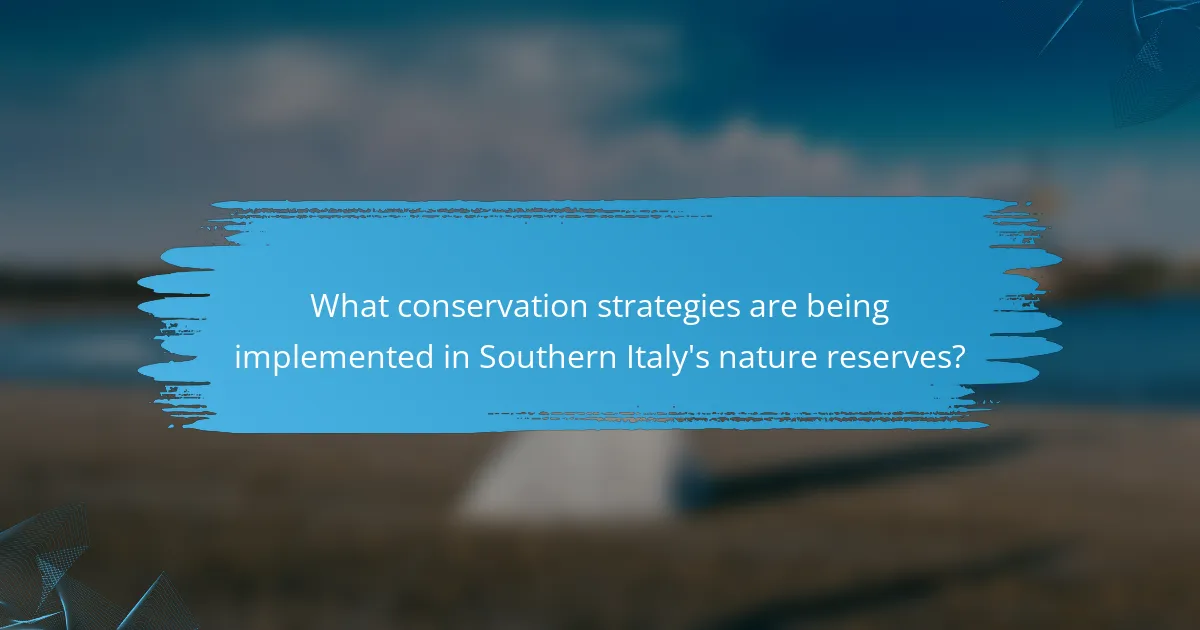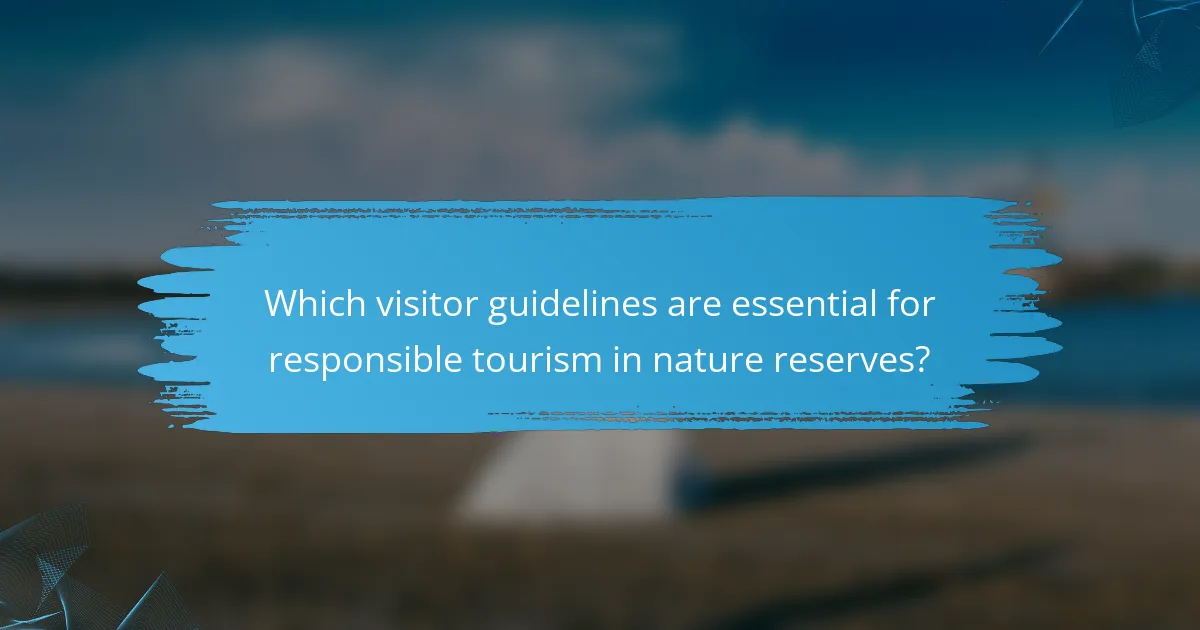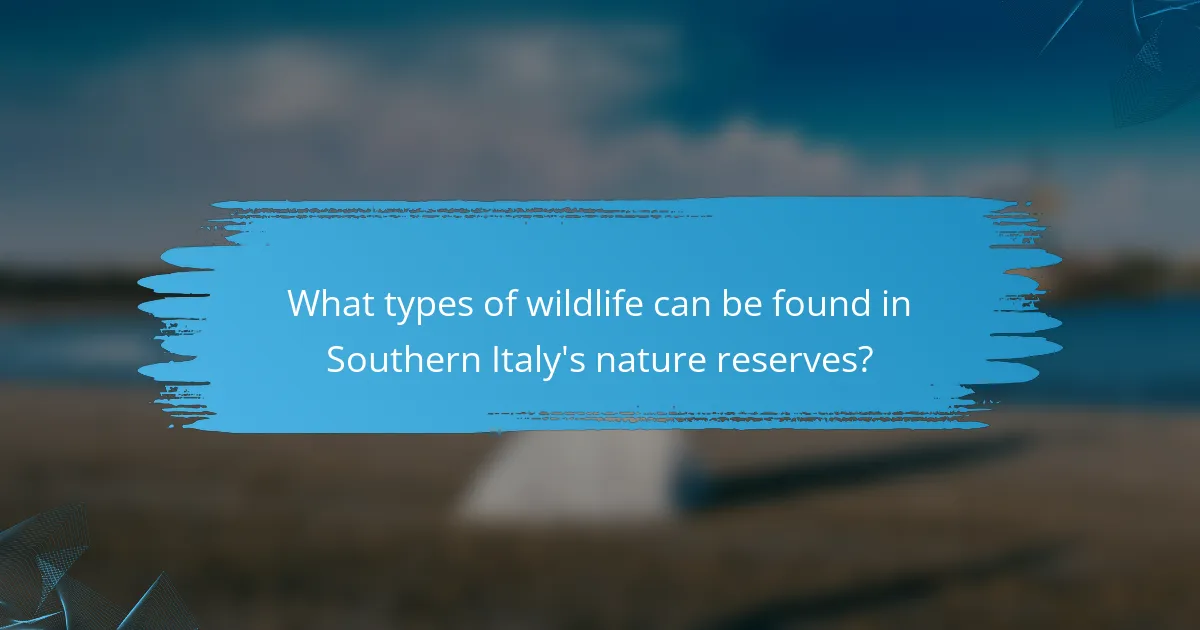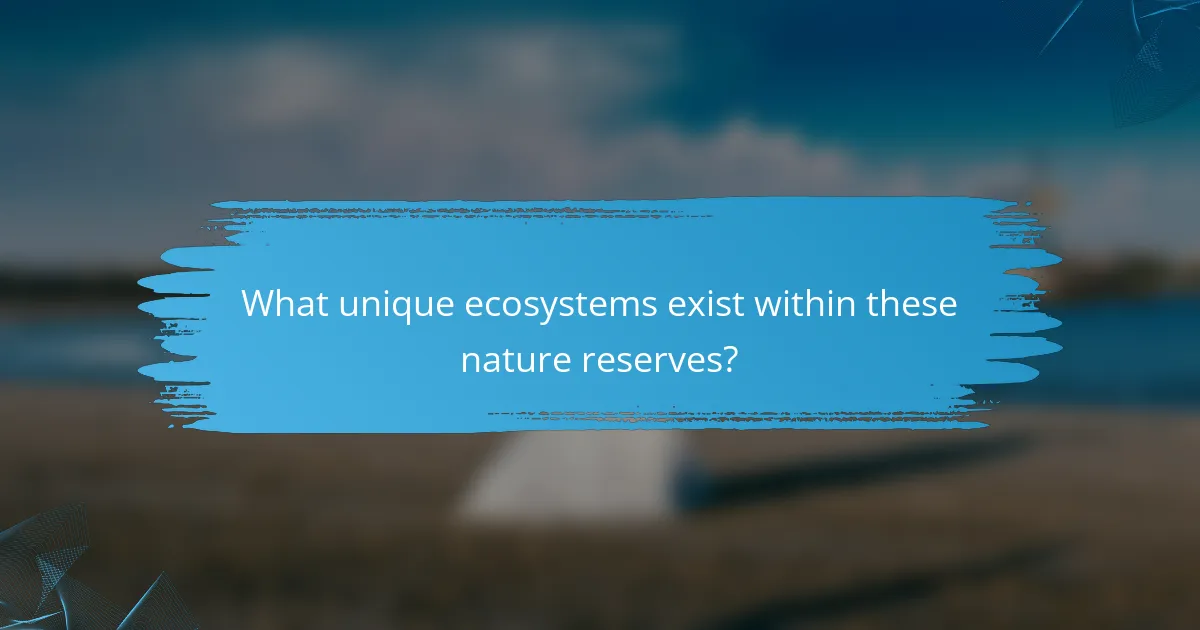Southern Italy’s nature reserves play a crucial role in preserving biodiversity amid challenges like habitat loss and climate change. This article explores conservation efforts, essential visitor guidelines for responsible tourism, and the rich wildlife diversity found in these unique ecosystems. Discover the strategies implemented to protect species and habitats, as well as the educational programs available for visitors. Understanding these aspects enhances appreciation for Southern Italy’s natural heritage.

What conservation strategies are being implemented in Southern Italy’s nature reserves?
Conservation strategies in Southern Italy’s nature reserves focus on habitat restoration, species protection, and sustainable tourism practices. Key initiatives include reforestation projects, wildlife monitoring programmes, and community engagement efforts. These strategies aim to preserve biodiversity and enhance ecosystem resilience while promoting responsible visitor guidelines to minimise human impact.
How do these strategies address local biodiversity?
These strategies enhance local biodiversity by protecting habitats and promoting species conservation. Nature reserves in Southern Italy implement management practices that restore ecosystems and create corridors for wildlife movement. These efforts include monitoring species populations and controlling invasive species. Additionally, visitor guidelines educate the public on the importance of biodiversity, fostering a culture of conservation within local communities. As a result, these initiatives contribute to the overall health of the environment and the sustainability of local ecosystems.
What role do local communities play in conservation efforts?
Local communities play a crucial role in conservation efforts by fostering stewardship and sustainable practices. Their involvement enhances biodiversity protection and promotes environmental awareness. Community-led initiatives often lead to effective management of nature reserves in Southern Italy, ensuring the preservation of wildlife habitats. Collaboration with local residents can improve visitor guidelines, making them more relevant and effective.

Which visitor guidelines are essential for responsible tourism in nature reserves?
Essential visitor guidelines for responsible tourism in nature reserves include respecting wildlife, staying on marked trails, and minimising noise. These practices help protect ecosystems and enhance wildlife diversity. Visitors should also avoid littering, maintain a safe distance from animals, and follow all local regulations. Responsible behaviour ensures the preservation of these natural habitats for future generations.
What are the regulations regarding wildlife observation and photography?
Wildlife observation and photography in Southern Italy’s nature reserves are regulated to protect ecosystems and species. Visitors must adhere to guidelines that include maintaining a safe distance from animals, avoiding disturbance to habitats, and obtaining necessary permits for photography. Specific regulations may vary by reserve, emphasising ethical practices and conservation efforts.
How can visitors minimise their ecological footprint?
Visitors can minimise their ecological footprint by following sustainable practices. First, choose eco-friendly transportation options like walking or biking within nature reserves. Second, respect wildlife by observing from a distance and not feeding animals. Third, stay on marked trails to prevent habitat destruction. Fourth, carry out all waste, including biodegradable items, to protect the environment. Lastly, support local conservation efforts through donations or volunteering, which enhances preservation initiatives.

What types of wildlife can be found in Southern Italy’s nature reserves?
Southern Italy’s nature reserves host diverse wildlife, including unique species. Common animals include the Italian wolf, wild boar, and various bird species like the Bonelli’s eagle. Rare species such as the Mediterranean monk seal inhabit coastal areas. Conservation efforts focus on protecting these habitats and species, ensuring their survival for future generations.
Which species are endemic to this region?
Several species are endemic to the nature reserves in Southern Italy, including the Italian wall lizard and the Aeolian wall lizard. These species showcase unique adaptations to their specific habitats, contributing to the region’s biodiversity. Additionally, the presence of rare plant species, such as the Sicilian fir, further emphasises the ecological significance of these reserves. Conservation efforts aim to protect these endemic species and their habitats from threats like climate change and habitat loss.
How do seasonal changes affect wildlife visibility?
Seasonal changes significantly influence wildlife visibility in nature reserves. During spring and summer, animals are more active and easily spotted due to mating behaviours and the abundance of food. In contrast, autumn and winter can reduce visibility as many species enter hibernation or migrate. Factors such as vegetation changes and weather conditions also play a role in wildlife sightings. For instance, in Southern Italy, the lush growth during warmer months enhances opportunities for observing diverse species.

What unique ecosystems exist within these nature reserves?
Unique ecosystems within nature reserves in Southern Italy include coastal wetlands, mountainous terrains, and Mediterranean forests. These diverse habitats support various flora and fauna, such as the endemic species of the Apennines and migratory birds in wetlands. The unique attribute of these ecosystems is their rich biodiversity, which enhances conservation efforts. For example, the Cilento and Vallo di Diano National Park features rare plant species and unique geological formations.
How do coastal and mountainous ecosystems differ in biodiversity?
Coastal ecosystems generally exhibit higher biodiversity than mountainous ecosystems due to their varied habitats and nutrient-rich environments. Coastal areas support diverse marine life, while mountainous regions often have specialised species adapted to specific altitudes. Coastal reserves in Southern Italy, such as the Cilento and Vallo di Diano National Park, protect various habitats like wetlands and rocky shores, fostering rich biodiversity. In contrast, mountainous reserves like the Aspromonte National Park focus on unique flora and fauna adapted to higher elevations, showcasing the unique adaptation strategies necessary for survival in these distinct ecosystems.
What rare species inhabit specific reserves?
Several rare species inhabit nature reserves in Southern Italy, including the Italian wolf, the Bonelli’s eagle, and the Mediterranean monk seal. These species face threats from habitat loss and climate change. Conservation efforts focus on protecting their habitats and promoting biodiversity. Visitor guidelines emphasise the importance of minimising human impact to support these unique wildlife populations.

What challenges do nature reserves in Southern Italy face?
Nature reserves in Southern Italy face significant challenges including habitat loss, pollution, and climate change. These factors threaten biodiversity and disrupt conservation efforts. Invasive species further complicate management strategies, impacting native wildlife. Limited funding hampers effective protection measures, while increasing tourism leads to habitat degradation.
How does climate change impact local ecosystems?
Climate change significantly impacts local ecosystems by altering species distributions, affecting food webs, and disrupting habitat stability. In Southern Italy, nature reserves are essential for conservation efforts, protecting diverse wildlife from these changes. Increased temperatures and shifting rainfall patterns threaten endemic species, while invasive species may proliferate in altered conditions. Conservation strategies include habitat restoration and sustainable tourism practices to minimise human impact. Visitor guidelines emphasise respecting wildlife and promoting awareness of ecological changes.
What are the main threats from urban development?
Urban development poses significant threats to nature reserves in Southern Italy, including habitat destruction, pollution, and invasive species. These factors disrupt ecosystems and threaten wildlife diversity. Conservation efforts must address these challenges to protect the unique attributes of these reserves. For example, urban expansion often leads to fragmentation of habitats, making it difficult for species to thrive.

What educational programs are available for visitors?
Nature reserves in Southern Italy offer various educational programs for visitors, including guided nature walks, workshops on local wildlife, and conservation lectures. These programs aim to enhance awareness of biodiversity and promote conservation efforts. For example, the Parco Nazionale del Cilento offers interactive sessions focusing on endemic species and sustainable practices. Additionally, many reserves provide educational materials and resources for schools and families, fostering a deeper understanding of the region’s natural heritage.
How do these programs enhance awareness of conservation issues?
Nature reserve programs enhance awareness of conservation issues by engaging visitors through education and immersive experiences. They provide guided tours, workshops, and informational signage that highlight local wildlife and ecosystems. These initiatives foster a connection between visitors and nature, promoting stewardship. Additionally, conservation programs often collaborate with schools and communities, amplifying their reach and impact. As a result, visitors leave with a greater understanding of the importance of preserving biodiversity in Southern Italy’s unique habitats.
What partnerships exist between reserves and educational institutions?
Nature reserves in Southern Italy partner with educational institutions to enhance conservation efforts and promote biodiversity awareness. These collaborations often involve research initiatives, student internships, and community outreach programs. For example, universities conduct ecological studies within reserves, contributing to scientific knowledge and conservation strategies. Additionally, educational programs foster environmental stewardship among students and local communities, ensuring sustainable practices are upheld. Such partnerships strengthen both academic and conservation goals, benefiting wildlife diversity and ecological health in the region.
What practical tips can enhance your visit to Southern Italy’s nature reserves?
To enhance your visit to Southern Italy’s nature reserves, follow these practical tips. Plan your visit during off-peak seasons to avoid crowds and enjoy a more serene experience. Always respect wildlife by maintaining a safe distance and not feeding animals. Carry reusable water bottles to minimise plastic waste and stay hydrated. Wear appropriate footwear for hiking and exploring diverse terrains. Familiarise yourself with local flora and fauna to appreciate the biodiversity, and consider joining guided tours for in-depth knowledge and safety.